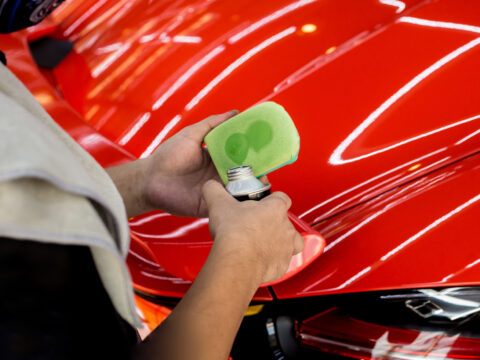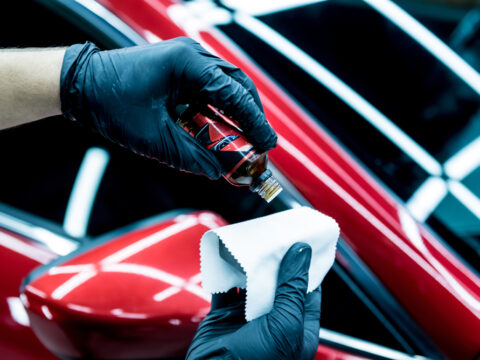Is dealer-applied paint protection worth the money? This question is one that many car buyers often ponder as they consider various dealership options. This comprehensive blog post will delve into the world of paint protection and its significance in maintaining your vehicle’s appearance.
We will discuss what paint protection entails and how it differs from ceramic coatings. Additionally, we’ll explore whether dealership-applied paint protection is necessary and evaluate its cost-effectiveness. Furthermore, we will examine if you can apply the protection yourself or if it’s best left to professionals.

Paint protection, also known as paint sealants, are products applied to a vehicle’s exterior surfaces to help preserve the car’s paint and clear coat from environmental damage, such as UV rays, bird droppings, tree sap, and light scratches.
Dealerships can offer these protective coatings as part of their dealer options when purchasing a new or used vehicle.
Contents
Is it the Same as a Ceramic Coating?
When discussing paint protection, it’s essential to understand that different types of products are available in the market. One common question among car buyers is whether paint protection and ceramic coating are the same. The short answer is no; they are not identical but serve similar purposes.
Ceramic Coatings: A More Advanced Option
In contrast, ceramic coatings consist of nano-ceramic particles that bond with your vehicle’s clear coat upon application. This layer creates a more durable and long-lasting barrier against contaminants than traditional wax or polymer-based sealants.
Ceramic coatings can endure for two to five years, possibly even more, depending on maintenance and exposure to extreme conditions.
Is It Necessary?
Dealer-applied paint protection is only sometimes necessary but can benefit some car buyers. The necessity of applying paint protection depends on various factors, such as your driving habits, where you live, and how well you maintain your vehicle.
Driving Habits and Environment
If you regularly drive on rough surfaces or in areas with extreme weather, like heavy rain and snowfall, then paint protection can help protect your car’s finish from chips and scrapes caused by particles kicked up off the ground.
Maintenance Routine
If you regularly wash and wax your car using high-quality products that provide UV resistance and water repellency, adding another layer of defense may not be essential.
Budget Considerations
If you’re trying to save money, it could be a wiser choice to buy good car wax or do-it-yourself ceramic coatings that offer comparable advantages for much less.
Resale Value
Dealer-applied paint doesn’t guarantee complete protection against all potential damage sources like stone chips or deep scratches. Therefore, considering alternative methods such as clear bras or vinyl wraps could be worth exploring if maintaining pristine paintwork is crucial for maximizing resale value.
How Much Does It Cost?
On average, you can expect to pay anywhere from $300 to $1,000 for a professional application. Some high-end luxury cars may even require more expensive treatments.
Suppose you’re considering applying for paint protection yourself instead of going through a dealership. In that case, Consumer Reports suggests that car owners should expect to spend between $50-$100 for materials alone when using DIY kits.
However, remember that proper application requires time investment and some skill; if done correctly, it can protect your car’s paint.

Why Dealerships Apply Paint Protection
Understanding dealerships’ motivations can help car buyers make informed decisions about whether or not to invest in this extra layer of protection for their vehicle’s exterior.
Enhanced Aesthetic Appeal
A primary reason dealerships apply paint sealants is to enhance the visual appeal of a vehicle, making it more attractive to potential buyers. Polymer paint sealants’ added shine and gloss could give cars a showroom-ready appearance.
Increased Profit Margin
Dealer options, such as paint protection, allow dealerships to increase their profit margins on each sale.
Protecting the Car’s Paint During Transport and Storage
Applying ceramic coatings or other protective treatments helps ensure the vehicles remain pristine until they reach their new owners.
Customer Satisfaction and Peace of Mind
Dealerships apply for paint protection to give their customers peace of mind knowing that their vehicle’s exterior is well-protected from potential harm caused by UV rays, bird droppings, tree sap, light scratches, and other environmental factors.
What If You Choose Not To Get Paint Protection?
If you choose not to get paint protection from a dealership, you will not have the added layer of protection that such treatment provides for your car’s paint job.
While paint protection can be beneficial in prolonging the life and appearance of your car’s paint job, it is not necessarily a requirement for all vehicles. It is ultimately up to you to decide whether you want to invest in this additional protection.
You can purchase paint protection products from auto parts stores or online retailers and apply them yourself. However, it is essential to research these products carefully and ensure they are appropriate for your vehicle’s paint type and color.
Can You Apply It Yourself?
Yes, it is possible to apply paint protection yourself. However, before you take on this task, consider a few things.
Various paint protection products, such as polymer paint sealants, ceramic coatings, and traditional waxes, are available. Choosing the right product for your vehicle is essential based on factors like durability, ease of application, and cost.
Applying paint protection requires some level of expertise and experience. In addition, to use any form of car paint protection effectively, you’ll need access to specific tools and equipment like microfiber towels, applicators, and possibly a dual-action polisher.
Depending on which type of protective coating or sealant you choose (ceramic coating vs. traditional wax), applying paint protection can be time-consuming – sometimes taking several hours or even days if multiple layers are required for optimal results.
Things to Consider
Before you commit to the dealership’s paint protection, there are a few points to ponder. These factors will help you determine whether this service is worth the money and is the right choice for your vehicle.
The Type of Paint Protection Offered
Different dealerships may offer different types of paint protection, such as polymer paint sealants or ceramic coatings.
Cost vs. Value
The cost of applying paint protection can vary significantly between dealerships, so feel free to look around and inquire about their products and services.
Warranty Coverage
If a dealership offers warranty coverage with their paint protection package, it could provide added peace of mind knowing that any issues related to your car’s paint will be taken care of by professionals without additional costs incurred by yourself.
Alternative Options for Paint Protection
If you need more convincing that dealership-applied paint protection is the best choice for your vehicle or budget, consider alternative options like DIY ceramic coatings or car waxes. These products can be more affordable and offer similar benefits in protecting your car’s clear coat from damage caused by environmental factors such as UV rays and acid rain.
Is It Worth the Money?
Dealership-applied paint protection can be a worthwhile investment for some car buyers but not everyone. Choosing this service depends on your budget, driving habits, and how much you value your vehicle’s appearance. To make an informed choice, consider the following factors:
- Budget: Paint protection services offered by dealerships can range from a few hundred dollars to over a thousand. If you have a limited budget or are not planning on keeping the car for an extended period, forego paint protection services may be more cost-effective.
- Maintenance Habits: Are you diligent about washing and waxing your car regularly? If so, traditional car wax might protect against light scratches and fading without breaking the bank.
- Parking Conditions: Do you frequently park outdoors in harsh weather or under direct sunlight? In such cases, ceramic coatings, which are more resistant to UV rays than traditional waxes and clear coats, might be a worthwhile investment to keep your car’s paint looking fresh.
- Resale Value: A well-maintained exterior can boost the resale value of your vehicle. If you plan on selling or trading in your car down the line, investing in dealership-applied paint protection could help maintain its appearance and ultimately fetch a higher price.
In conclusion, while dealer-applied paint protection isn’t necessary for every car buyer, it can benefit those who prioritize their vehicle’s appearance and long-term value. Weighing these factors against the cost will help determine if this service is worth your investment.
Whether you choose traditional wax, polymer paint sealants, ceramic coatings, or other options, keeping your car’s paint and interior protected can help keep your vehicle looking new for years.














